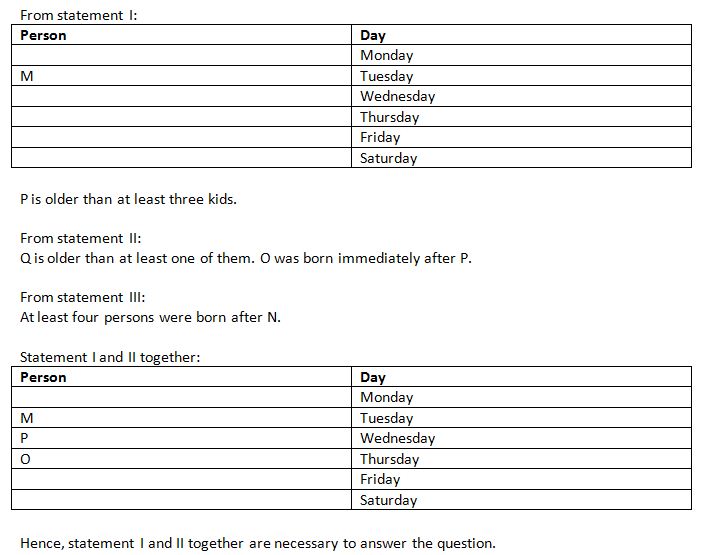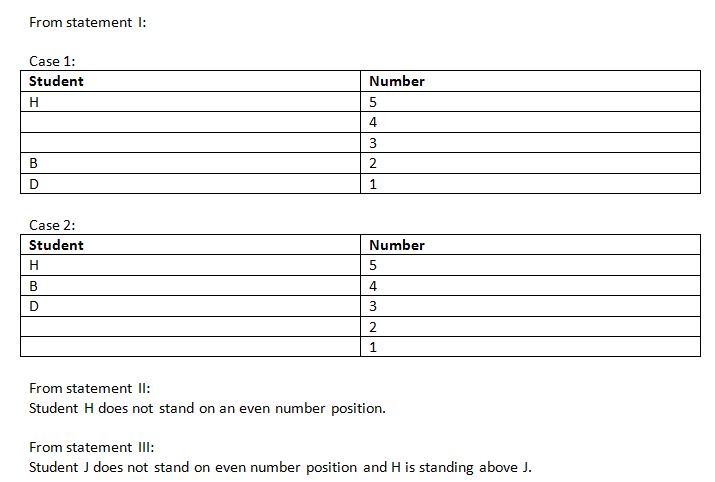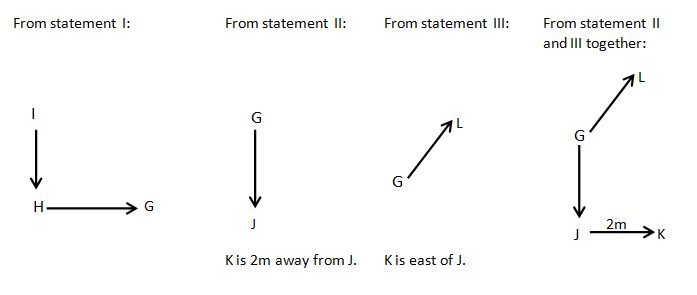Welcome to Online Quantitative Aptitude section in AffairsCloud.com. Here we are creating question sample From DATA SUFFICIENCY which is BASED ON Bank EXAMS 2019 !!!
Data Sufficiency
(Directions 1 – 10): Study the following information and answer the questions given below:
- How is A related to B?
I. A is the mother-in-law of C who is the father of B.
II. D is the grandfather of B and also the husband of A.
1) If the data in statement I alone are sufficient to answer the question, while the data in statement II alone are not sufficient to answer the question.
2) If the data in statement II alone are sufficient to answer the question, while the data in statement I alone are not sufficient to answer the question.
3) If the data either in statement I alone or in statement II alone are sufficient to answer the question.
4) If the data even in both statements I and II together are not sufficient to answer the question.
5) If the data in both statement I and II together are necessary to answer the question.Answer – 3) If the data either in statement I alone or in statement II alone are sufficient to answer the question.
Explanation :

- Six kids viz. M, N, O, P, Q and R were born in the same week starting from Monday to Saturday, one on each day. How many of them are older than O?
I. P is older than at least three kids. M was born on Tuesday.
II. Q is older than at least one of them. O was born immediately after P.
III. At least four persons were born after N.
1) If the data in statement I and II are sufficient to answer the question
2) If the data in statement II and III are sufficient to answer the question
3) If the data in statement I and III are sufficient to answer the question
4) If the data in all the statement I, II and III together are not sufficient to answer the question
5) If all the statements I, II and III are necessary to answer the questionAnswer – 1) If the data in statement I and II are sufficient to answer the question
Explanation :

- There are 5 students B, D, F, H, and J who are standing according to their weight. What is the position of student F?
(I) Student H is the heaviest. D is just behind B but not on even numbered position.
(II) Student H does not stand on an even number position.
(III) Student J does not stand on even number position and H is standing above J.
1) If the data in statement I alone or in the statement II alone or in the statement III alone is sufficient to answer the question.
2) If the data in statement I and II together are sufficient to answer the question, while the data in statement III are not sufficient to answer the question.
3) If the data in statement I and III together are sufficient to answer the question, while the data in statement II is not sufficient to answer the question.
4) If the data in statement II and III together are sufficient to answer the question, while the data in statement I is not sufficient to answer the question.
5) If the data in all the statement I, II and III together are not sufficient to answer the question.Answer – 5) If the data in all the statement I, II and III together are not sufficient to answer the question.
Explanation :


- Who amongst P, Q, R, S and T is the first to take the lecture?
I. P takes lecture before S and Q but not before T.
II. R is not the first to take the lecture.
III. S is not the last to take the lecture.
1) Only I and either II or III
2) Question cannot be answered even with all the statements together
3) Only statement I
4) Only statement III
5) Both statement I and IIAnswer – 5) Both statement I and II
Explanation :
From statement I:
P > S, P > Q, T > P
From statement II:
R is not the first to take the lecture.
From statement III:
S is not the last to take the lecture.
Both statements I and II together:
T > P > S, Q and R is not the first to take the lecture.
Hence, T takes the first lecture.
So, statement I and II together are necessary to answer the question. - What is the direction of bike G with respect to bike K?
I. G is to the east of H and to the south of I.
II. J is to the south of G and K is 2m away from J.
III. L is to the north east of G and K is to the east of J.
1) Only III
2) Only I and II
3) Only II and III
4) Question cannot be answered even with all I, II & III
5) None of theseAnswer – 3) Only II and III
Explanation :

- There are six members F, H, J, L, M, and N in a family, how is M related to L?
I. L is son of J. F and N are child of H. M is grandfather of F.
II. J is mother-in-law of H, who is a female member. L has no brother.
1) If the data in statement I alone are sufficient to answer the question, while the data in statement II alone are not sufficient to answer the question.
2) If the data in statement II alone are sufficient to answer the question, while the data in statement I alone are not sufficient to answer the question.
3) If the data either in statement I alone or in statement II alone are sufficient to answer the question.
4) If the data even in both statements I and II together are not sufficient to answer the question.
5) If the data in both statement I and II together are necessary to answer the question.Answer – 5) If the data in both statement I and II together are necessary to answer the question.
Explanation :

- Six persons B, D, F, H, J and L are sitting in a row facing in the north direction. Who sits between F and J?
(I) B sits second from the left end. F sits third to the left of D who is near to J.
(II) D is not an immediate neighbour of L who does not sits any extreme end of the row.
(III) J is not the neighbour of B.
1) If the data in statement I alone or in the statement II alone or in the statement III alone is sufficient to answer the question.
2) If the data in statement I and II are sufficient to answer the question, while the data in statement III are not sufficient to answer the question.
3) If the data in statement I and III are sufficient to answer the question, while the data in statement II is not sufficient to answer the question.
4) If the data in statement II and III are sufficient to answer the question, while the data in statement I is not sufficient to answer the question.
5) If the data in all the statement I, II and III are necessary to answer the question.Answer – 2) If the data in statement I and II are sufficient to answer the question, while the data in statement III are not sufficient to answer the question.
Explanation :

- Statement: On which day of the week did Ritesh took leave to Mumbai visit starting from Monday.
I. Ritesh took leave on Wednesday.
II. Ritesh visited Mumbai day after his mother’s visit to his house, he visited in last half of the week.
III. Ritesh’s mother visited Ritesh’s house neither on Monday nor on Thursday.
1) Only I and either II or III
2) Question cannot be answered even with all the statements together
3) Only statement I
4) Only statement III
5) Both statement I and IIAnswer – 2) Question cannot be answered even with all the statements together
Explanation :
From statement I:
Ritesh took leave on Wednesday.
From statement II:
Ritesh’s Mother reach Mumbai before Ritesh. Ritesh visited in last half of the week.
From statement III:
Ritesh’s mother neither visited on Monday nor on Thursday.
By combining all the statements together question cannot be answered.
Hence, question cannot be answered with all the statements together. - What was the grand total of Team B in today’s match?
I. Mohan correctly remembers that team B scored a grand total of above 62 but below 71.
II. Aman correctly remembers that team B scored above 57 and below 64.
1) The data in statement II alone are sufficient to answer the question, while the data in statement I alone are not sufficient to answer the question
2) The data even in both statements I and II together are not sufficient to answer the question
3) The data either in statement I alone or in statement II alone are sufficient to answer the question
4) The data in statement I alone are sufficient to answer the question, while the data in statement II alone are not sufficient to answer the question
5) The data in both statements I and II together are necessary to answer the questionAnswer – 5) The data in both statements I and II together are necessary to answer the question
Explanation :
From statement I:
Team B scores either 63, 64, 65, 66, 67, 68, 69 or 70.From statement II:
Team B either scores 58, 59, 60, 61, 62 or 63.From statement I and II together:
Team B scores 63 runs. - Among persons S, T, U, V, W and B which is the tallest?
I. U is taller than only two persons. T is taller than S but not the tallest. W is taller than only B.
II. S is shorter than only two persons. W is taller than B but shorter than U. U is shorter than S. T is shorter than V.
1) The data in statement II alone are sufficient to answer the question, while the data in statement I alone are not sufficient to answer the question
2) The data even in both statements I and II together are not sufficient to answer the question
3) The data either in statement I alone or in statement II alone are sufficient to answer the question
4) The data in statement I alone are sufficient to answer the question, while the data in statement II alone are not sufficient to answer the question
5) The data in both statements I and II together are necessary to answer the questionAnswer – 3) The data either in statement I alone or in statement II alone are sufficient to answer the question
Explanation :
From statement I:
U is taller than only two persons. T > S but T is not the tallest. W is taller than B only.
V > T > S > U > W > B
From statement II:
S is shorter than only two persons. W > B, U > W. S > U. V > T
V > T > S > U > W > B
Hence, the data either in statement I alone or in statement II alone are sufficient to answer the question.
AffairsCloud Recommends Oliveboard Mock Test
AffairsCloud Ebook - Support Us to Grow
Govt Jobs by Category
Bank Jobs Notification










